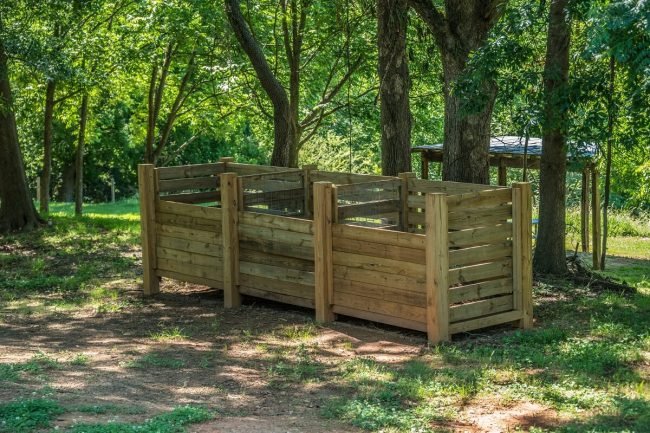Where Does Your Food Waste Go?
Composting is a win-win because not only does it prevent food products from winding up in landfills, it delivers vital nutrients to the soil in your community. Composting also reduces the need for synthetic fertilizers, cuts methane emissions from landfills, lowers the resources needed for irrigation by helping soil retain moisture…lots of wins going on!
Depending on whether we pick up your food waste or you drop it off, the process of breaking down food waste into compost happens at two main kinds of places: commercial composting facilities and community gardens.
A: Commercial Composting Facilities
When we collect from our customers, we take your compostable waste to a commercial composting facility.
Also known as industrial composting, commercial composting facilities are large operations that can typically handle many different kinds of organic material and generate several different varieties of compost in high volumes. These large facilities have industrialized the process of composting to streamline it and scale it. Once they have sorted the waste and removed any non-compostable materials, they may use one or more of the following composting methods, depending on their capabilities:
Windrow Composting
This form of composting gets its name from piling organic waste in long rows, although the exact method can vary significantly depending on the operator.
In many operations a large tractor called a turner is driven slowly over each row to mix the contents, which can reach up to 140 degrees inside the pile. Turning every three days to weekly, the active portion of windrow composting food waste takes about six months.
Large scale industrial composting requires planning, skill, and good fortune. Most facilities are located far from city centers, where land costs and distance from neighbors reduces headaches.
In-Vessel Composting
Instead of composting in the open air, a commercial facility may move the food waste into a plastic or metal tank, drum, or silo. There it can be composted under carefully controlled conditions of air flow, temperature, and moisture without creating nuisance odors.
Using this technique, compost can be ready for cooling in just a few weeks.
Aerated Static Pile
This method combines the pile structure of windrows with the piped-in air of composting vessels, while removing the need for turning. Loosely piled bulking agents such as shredded newspaper and wood chips are added to the pile to help facilitate air flow.
Although this method doesn’t work well with animal byproducts or grease, it is excellent for composting food scraps and can do so within three to six months.
B: Community Gardens
Food waste generated by our customers can end up in a community garden in two ways: 1) Residential drop-off subscribers take their food waste directly to a community garden where it is converted to compost; 2) For pick up customers, the compostable waste is first taken to a commercial composting facility where it is turned into compost. If pick up customers choose not to accept their earned compost, it is instead donated to a community garden.
A community garden is a long-term undertaking that requires dedication and know-how to achieve success, making composting a natural fit. In community gardens, area residents work together to grow produce or flowers, often helping ease food insecurity, boosting the local economy, improving air quality, and fostering strong relationships among neighbors.
Because budgets are typically small, composting is super-attractive as a free source of organic fertilizer. Vegetation waste such as stems, stalks, leaves, rotted vegetables, and trimmings that would otherwise be thrown out can help create nutrient-rich compost for the garden. And with a compost system in place, it’s easy to add food scrap drop-off so that anyone can contribute to the garden by bringing their food waste for composting.
Worms will not be added to a 3-bin system if the operators are attempting hot composting, in which the goal is letting the sun and the microbial activity spurred by the ideal carbon-to-nitrogen ratio of 25:1 heat the inside of the heap up to 140 degrees. Hot composting requires regular turning and ample outdoor space for the requisite large bin.
Another option for community growers is a keyhole garden. Deriving its name from the cutout shape created by the gap in the stones that allows easy access to the center of the ring-shaped bed, a keyhole garden features a compost basket in the center and closely placed plants surrounding it. As the compost is watered, nutrients wash from the basket into the rest of the bed, naturally fertilizing the plants.
To produce high volumes of compost relatively quickly, community gardens often use what’s called the 3-bin system. Whether homemade from wood or wire, or store-bought and made of steel or plastic, a 3-bin composter is a long container (at least 9 feet) with dividers creating three sections. Compost is poured into one bin, then moved into the second bin as a way to turn it and to make room for more compost in the first bin.
Composting worms can be added to the bins to help break down the waste faster. Such “vermicomposting” also produces compost that results in soil with better aeration, porosity, bulk density, and water retention. One advantage of vermicomposting is that it can be done indoors.
Where Does the Compost Go?
If you choose, your compost can go to you! Twice per year we can deliver whatever compost your donations have earned you over the course of the year for your own use.
Food waste that goes to a commercial facility and is transformed into compost may end up at a farm or nursery, or sold to the general public for private use.
Community gardeners typically use the compost they create from food waste themselves, or they share it with other gardens or local farms or parks.







